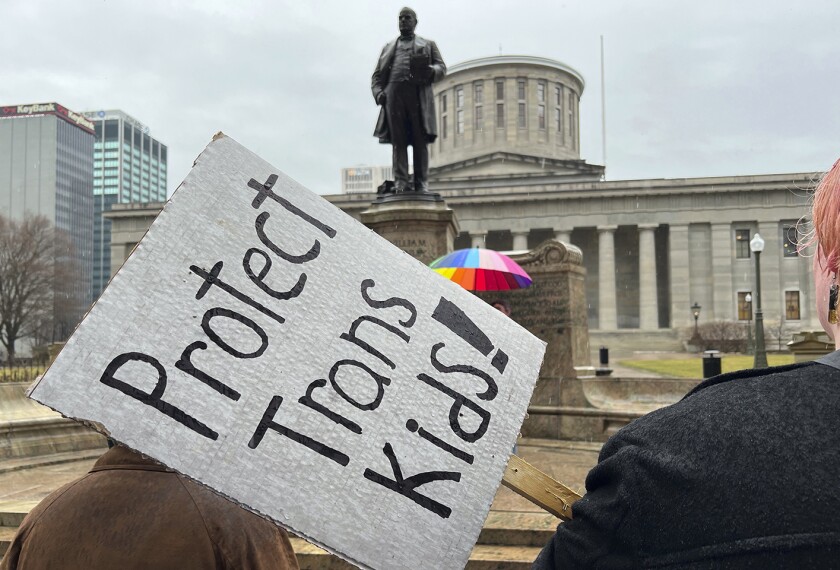President Donald Trump’s budget proposal for the U.S. Department of Education made plenty of waves for its emphasis on school choice and its cuts to long-standing programs—but Congress has no obligation to go along with the plan, and there hasn’t been a show of overwhelming support for either idea on Capitol Hill just yet.
The fiscal 2018 proposal from the Trump administration emphasizes the commitment to choice and austerity, despite the political sensitivities involved.
It would cut $9.2 billion, or 13.5 percent, from the Education Department’s budget, bringing it down to $59 billion. It would launch a new $1 billion grant program for public school choice under Title I; increase charter school funding by about 50 percent, to $500 million; and create a $250 million grant program in the Education Innovation and Research program to fund private school vouchers and research their effects.
The $250 million grant program would be enough to provide 17,500 to 26,000 vouchers to private schools, including religious ones, in the range of $8,000 to $12,000 per student. However, a spokeswoman for the department denied that the new $250 million program would constitute a federal voucher program, arguing instead that the department would be supporting states that applied for the grants to expand school choice.
Meanwhile, $2 billion in grants for teacher development and class-size reduction under Title II would be eliminated in Trump’s budget, along with $1.2 billion in after-school and summer programs, and $400 million for a new block grant under Title IV of the federal education law for programs for student health, education technology, and other issues. Title I and special education funding would also get cut by roughly 4 and 1 percent, respectively, from fiscal 2017 levels.
Divergent Views
Lawmakers in charge of the department’s budget shared divergent views about the Trump spending proposals during a House hearing last week, where U.S. Secretary of Education Betsy DeVos defended the budget. It was her first public appearance on Capitol Hill since her contentious confirmation hearing.
Rep. Tom Cole, R-Okla., the chairman of the House Appropriations subcommittee that funds the department, praised the blueprint for promoting educational opportunities in general. But he didn’t discuss the Title I choice fund or the voucher proposal, and after the hearing stressed he wasn’t ready to pick “winners and losers” in the education budget yet.
“I’m a big fan of charter schools,” Cole said, when asked about distinctions he was making between charters and vouchers in the budget. And he questioned the proposal’s cuts to GEAR UP and TRIO, two programs that help disadvantaged students reach postsecondary education.
Meanwhile, Democrats hammered DeVos over the various cuts, and also sparred with the secretary about whether she would allow a federal voucher program to fund private schools that discriminate against students, including LGBT children and African-American students. DeVos emphasized state prerogatives and parent choice in her answers, but in a later statement also emphasized that schools participating in the new $250 million voucher research program would have to follow federal law.
“I’m shocked that you cannot come up with one example of discrimination [where] you would stand up for students,” Rep. Katherine Clark, D-Mass., told DeVos during the discussion of vouchers.

Despite the administration’s proposed cuts to several programs, it’s likely that Title I, Title II, and the Title IV block grant will be funded at roughly the same levels they are now, said David DeSchryver, the senior vice president at Whiteboard Advisors, a research and advocacy firm. The Title I choice program would require a politically difficult change in federal law, he noted. And the $250 million voucher research program might be too small to justify politically, DeSchryver added.
“This puts a lot on the congressional plate, and I don’t think they’re ready to navigate yet how all this will work,” DeSchryver said.
Trump’s budget plan represents the biggest single-year overall proposed cut to the department since President Ronald Reagan’s budget pitch for fiscal 1983. Congress ultimately increased the department’s budget for that year.
In her testimony to House lawmakers, DeVos repeatedly stressed that the budget makes tough choices and puts what she called appropriate new limits on the federal government’s involvement in education. And she said that giving more power to parents and students, along with states and local communities, is long overdue.
“Instead, we spend a lot of time talking about schools and systems,” DeVos said.
She also said that despite the cuts, the Every Student Succeeds Act (the federal education law that kicks in for the 2017-18 school year) and other changes in the budget proposal would allow schools to be more flexible and to better serve students. But Democrats countered that any such flexibility was dwarfed by the range of proposed cuts.
On the Chopping Block
The budget would phase out or eliminate a total of 22 programs.
DeSchryver said Comprehensive Literacy Development Grants, which currently get $190 million but would be eliminated in Trump’s budget, are in serious jeopardy.
Outside of the Education Department, the budget plan proposes an $85 million cut to Head Start, which is administered by the Department of Health and Human Services. There would also be cuts to the National Center for Child Health and Human Development of $1 billion, as well as a reduction for the Children’s Health Insurance Program of $5.8 billion over 10 years.
Several school advocacy groups swiftly condemned the budget proposal. The Council of Chief State School Officers said the “cuts to key federal education programs” were “unacceptable.” And the National School Boards Association called the proposed cuts a “devastating blow” that would be compounded by the budget’s attempt to create “a second system of taxpayer-funded education” outside of traditional public schools.
A few school choice advocates were also wary of the choice proposals in the budget. For example, Lindsey Burke, the director of the Center for Education Policy at the Heritage Foundation, which favors limited government, said that the federal government should not be involved in running school choice, even as she praised the overall reduction in the Education Department’s budget.
“The Trump administration has outlined a budget that rightly downsizes spending and program count at the Department of Education—a long overdue step that can pave the way for a restoration of state and local control of education,” Burke said.






